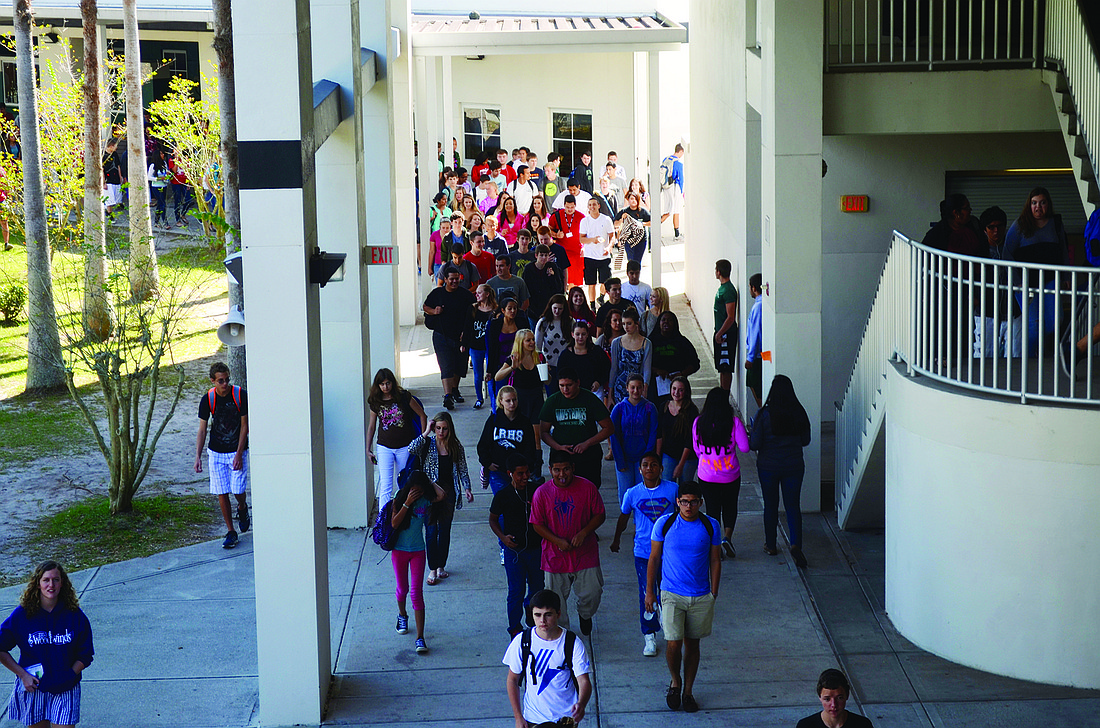- April 23, 2024
-
-
Loading

Loading

EAST COUNTY — Lakewood Ranch High School instructor Tom Honsa allows as many students to enroll in his classes as the fire marshal will allow.
He reaches his cut-off point when he runs out of computers and seats, which is a common occurrence in the seven social studies and journalism class periods he teaches. Last year, he taught about 150 students. This year, he’s approaching 200.
Enrollment isn’t just up in Honsa’s classes. The East County high school is experiencing a spike in enrollment school-wide. Registration numbers are climbing toward 2,300 — more than 200 students above 2013-14 school year student counts.
Lakewood Ranch High is working to address the issue with two portables it added last week. One portable will be converted into a computer lab and the other’s use is still pending, said school Principal Craig Little.
In addition, Honsa and 11 other instructors also voluntarily eliminated their planning periods and are teaching an extra class. They now teach seven classes rather than six, so students aren’t turned away from the elective courses they want to take.
Elective courses are also fuller than they’ve been in at least four years, teacher Bobbi Colson estimated.
To Honsa, there are downfalls to taking on an extra class and more students. He has worked at the school since it opened in 1998 and has witnessed similar enrollment spikes at Lakewood Ranch High in the seven years before neighboring Braden River High School opened in 2005.
“We’ve gone through this before, this growth,” Honsa said. “But, with this schedule, it does probably gives less individual attention to students. Teachers end up taking more work home, because we don’t have that extra time to grade and to plan lessons.”
To avoid getting behind on grading tests and giving feedback on assignments, he won’t hand out in-depth assignments back-to-back.
Colson, a seven-period instructor, sees more filled seats in her classroom as a sign that her technology program is growing.
Two years ago, when she taught six classes, she oversaw about 170 students.
This year, she teaches 230.
Colson instructs three levels of Web design and animation courses. Along with Honsa, she’s also an instructor who helped open the school 15 years ago and has seen a transformation in her classrooms.
Today, the majority of her class periods feature multiple courses in one course. She combines second- and third-level Web design courses, and groups various levels of animation students together in single classes.
Students in her Web Design II course sit beside peers in the third-level of the course, in some of her classes.
She explains lesson plans for each course, starting with the lowest course level. She gives each course individualized attention and the day’s assignments before moving on to the next one.
Colson admits she isn’t able to give as much personalized attention to her students as she once was able.
But, she sees benefits to course combination.
“Having a student next to you doing a next level assignment enhances the learning experience,” Colton said. “The younger-level student wants to learn that too, and it gives them a preview for what they’ll be doing next year. I think this style works; it’s helping my program grow.”
Teachers of elective courses are experiencing the biggest increase in students, because core courses, such as English and Math, have limits on class size.
Florida’s class size reduction amendment took effect in the 2010-11 school year, and states that high school core classes can’t exceed 25 students in one period.
There are currently no enrollment limitations in place for elective courses.
A growing interest
Although no additional teachers will be hired to address the extra students yet, Little isn’t ruling out a larger staff.
He’s maintaining a proactive approach by keeping the resumes he receives, should the school continue to grow as he expects it will.
He expects to hire more teachers in the future.
“Teachers are volunteering because they want to build up their programs,” Little said. “We aren’t at the point, yet, where we need to hire more teachers. But, if a year later, the demand is still there, then we’ll add to our staff.”
A teacher picking up additional classes isn’t a new practice, he said.
More students in classes means programs are successful and students have an interest in what they’re learning, Little said.
For Little, who became Lakewood Ranch High’s principal in August, growth is always positive.
“We’re successful academically, and with the number of housing developments being built, it’s just a growing area,” he said.
